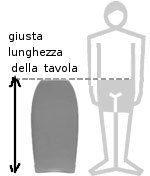How to choose the right length bodyboard
| Length ( inches ) | Height (cm) | Weight (kg) |
| 37 | 123 – 153 cm | 28 – 55kg |
| 37.5 | 130 – 155 cm | 30 – 55kg |
| 38 | 135 – 155 cm | 35 – 58kg |
| 38.5 | 140 – 158 cm | 38 – 58kg |
| 39 | 137 – 162 cm | 40 – 60kg |
| 39.5 | 147 – 165 cm | 42 – 65kg |
| 40 | 157 – 167 cm | 42 – 72kg |
| 40.5 | 158 – 170 cm | 50 – 80kg |
| 41 | 160 – 173 cm | 55 – 85kg |
| 41.5 | 165 – 179 cm | 60 – 90kg |
| 42 | 168 – 183 cm | 65 – 95kg |
| 42.5 | 170 – 190cm | 70 – 100kg |
| 43 | 172 – 195cm | 70 – 105kg |

How To Choose The Right Length Bodyboard
Choosing the right length for a bodyboard is essential to ensure an optimal riding experience. The board must be in harmony with the physical characteristics of the rider, considering height and weight. A balanced body on the board not only improves balance, but also allows you to make the most of the characteristics of the waves. Here are some useful guidelines for choosing the most suitable bodyboard based on the height and weight of the rider.
First, it’s important to understand that bodyboards come in a variety of lengths, usually measured in inches. A longer board offers more surface area and buoyancy, which can be beneficial for beginners and those who want more stability. On the other hand, a shorter board can offer more maneuverability and control, which is ideal for more advanced riders.
To determine the ideal length, it helps to consider the height of the rider. Longer boards, usually over 42 inches, are suited for taller riders, over 6 feet. These boards provide more surface area to distribute the body weight more evenly, making it easier to maintain balance while riding the wave. On the other hand, shorter boards, between 36 and 42 inches, are suited for shorter riders, usually under 6 feet, providing better maneuverability and control.
However, height alone may not be enough. Rider weight is just as critical when choosing a bodyboard. A heavier rider will require a larger board to ensure sufficient buoyancy and stability. For example, a heavier rider may want to go for a board over 43 inches to ensure adequate buoyancy and a good riding experience.
It is also important to consider the skill level of the rider. Beginners can benefit from longer, more stable boards that make it easier to learn how to balance and catch waves. As the rider gains more experience, they can choose shorter boards to improve maneuverability and the ability to perform more advanced tricks.
Another crucial aspect is the type of waves the rider expects to ride. Bigger waves require longer boards to provide the buoyancy needed to catch and ride them successfully. On the other hand, in smaller, faster waves, a shorter board may be preferable for greater maneuverability.
The choice of board material is also important. Bodyboards are mostly made of foam or hybrid materials. Foam boards are lightweight and offer superior buoyancy, making them ideal for beginners. However, hybrid boards, which combine foam with stiffer materials like high-density polyethylene, offer greater strength and durability, making them ideal for more experienced riders and those looking to ride more challenging waves.
Ultimately, choosing the right bodyboard requires careful consideration of several factors, including the rider’s height and weight, skill level, and expected wave conditions. Bodyboards are designed to suit a variety of riders and conditions, and choosing wisely will help enhance your bodyboarding experience and ensure long-lasting fun on the water. Before purchasing, it’s a good idea to consult with industry experts or visit a bodyboarding shop for more personalized advice on the right bodyboard for your needs.
To find the right bodyboard model, it is essential to carefully examine the specific features and technical considerations. Bodyboards come in a wide range of models, each designed to meet different needs and riding styles. Here are some things to consider when looking for the ideal model :-
- Shape and Contour : The profile and contour of the board are crucial. Boards with a scoop tail, for example, offer more stability, while those with a fin tail allow for more agile maneuvers. Additionally, the shape of the top of the board, called the deck, can vary, offering different levels of comfort and control.
- Stringer System : Some boards incorporate one or more stringers, which are strips of stiffer material down the center of the board. These stringers add strength and durability to the board, but can also affect flex. More advanced riders may prefer boards without stringers for more flex and wave feel.
- Core Material : The core material of the board is another crucial element. Boards can have a foam core made of expanded polyethylene (EPS) or high-density polyethylene (HDPE). EPS provides superior buoyancy, while HDPE is stronger and more durable. Hybrid boards often combine these materials to get the benefits of both.
- Slick (Bottom of the Board) : The bottom of the board, called the slick, can be made of different materials. Surlyn is commonly used for its resistance to abrasion and flex, while the HDPE bottom can offer more speed on the wave. The choice of slick material affects the speed, maneuverability and durability of the board.
- Rail (Side Edge of the Board) : The shape of the rail, or side edge of the board, is an important aspect. Thinner rails provide more maneuverability, while thicker rails provide more buoyancy and stability. More advanced riders may prefer thinner rails for more agile maneuvers, while beginners may prefer thicker rails to make learning easier.
- Channels and Crescent Tails : Some boards feature channels, grooves on the bottom, that affect directionality and speed. A crescent tail, a half-moon shape on the bottom of the board, is commonly preferred for its balance between stability and maneuverability.
- Brand and Reviews : Looking at reviews from other bodyboarders and considering the most reputable brands in the industry can be helpful in choosing the right model. Expert and user opinions give an idea of the quality and performance of the board.
Always remember that choosing the right model also depends on the rider’s experience level. Beginners can benefit from more stable and easy-to-handle boards, while more experienced riders can look for more advanced models that offer specific performance for their riding style.
Before purchasing, it is advisable to test different boards if possible, perhaps by renting or using boards from friends. This gives you the opportunity to evaluate which model best suits your needs and personal preferences. In addition, going to a specialized shop or consulting industry experts can provide personalized advice based on your specific needs and local wave conditions. Choosing a bodyboard is a crucial step in enjoying this exciting aquatic discipline to the fullest.
